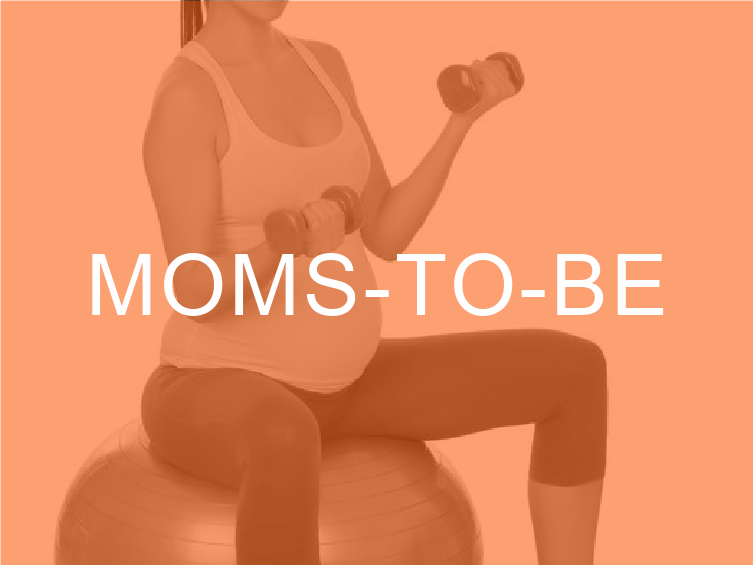
First-time pregnancy can be the most exciting time of a woman’s life. And for some, also some of the most physically challenging! For moms-to-be who have never really worked out before and come to you for guidance, you are in a unique position to both help her navigate completely new territory with her body and with exercise, and also set her on a path of future wellness.
She may come to you with a head swimming with myths about pregnancy and exercise that you’ll have to debunk for her. Reassure her that she is taking the right step and that it’s never too late or a bad time to make the body stronger unless an illness or disability precludes it. Pregnancy is not a disability!
Programming for Pregnancy
When working with moms-to-be who are also new to exercise, the key is to start slow and work your way up to 30 minutes of exercise. Always start with medical professional clearance and some basic fitness assessments. How far along your client is in her pregnancy will also dictate how she’s feeling and what she’s capable of.
The first few sessions can be 15-20 minutes of low to moderate intensity exercises and core work. Keep an open line of communication, let your client know she is in charge and to trust her body and listen to her instincts. Let her know that warning signs of overtly high-intensity include dizziness, feeling deeply exhausted, and light-headedness.
Pregnancy can do funky things to the body. Moms-to-be will often report feeling as though they are inhabiting someone else’s! The most important thing to bear in mind is how much pressure can be felt in the abdomen starting around the middle of the second trimester. That doesn’t mean she can’t connect with her core. On the contrary, this is a fantastic time to help her bring attention to her pelvic floor and strengthen the deep core muscles with Kegels and other activation exercises, which will aid her in a vaginal birth and recovery from birth no matter how the baby is delivered.
Start every session with core connection and activation exercises and then add a basic strength circuit of squats, pushes, and pulls, and end with some light cardio.
Moms-to-be Considerations
- Don’t move her too quickly between exercises, especially from sitting to standing or ground to standing
- Joints will have increased mobility thanks to the release of the hormone relaxin, which prepares the pelvis for birth. Keep joint stability in mind and avoid exercises that require excessive balance or agility and high impact exercises
- Avoiding twisting or crunching of abdomen once she has entered second trimester
- No supine exercises after the second trimester
- Note that many moms may have gained a lot more weight than they would have liked during their pregnancy and this may be their prime motivation for working with you. Remind them that they need to be patient with their body and then slow and steady wins the race!
When working with moms-to-be who are also new to exercise a lot of my workouts maintain a standing position or modified floor exercises. Here are some examples:
- To strengthen abdominals without crunches or lying on one’s back is definitely doable. Try having the client do various plank exercises with the modification of hands on a box of 12” or higher. When I have my client do Mountain Climbers she likes to pull the leg into the body at a slight external rotation. So instead of my usual cue, “Draw knee towards chin” I direct her to “Draw knee towards elbow”. This feels better on her hips and makes room for the bump.
- I also like to use Bird-Dogs to help strengthen the core muscles
- Since lying down is out of the picture second trimester on, I use single hand standing cable chest press.
- When working on squats I usually keep the weight held in front of the body, this also helps to strengthen the abdominals as well as the usual musculature that squats are prime for
- With back lunges I have my client use a TRX or any other sort of hand support to provide balance assistance
- Within the first few sessions I use resistance bands for rows, leg abductions and kickbacks, overhead presses, chest press and chest flies, and lat-pull downs. Especially if the client is starting their exercise routine while pregnant, resistance bands are a great tool to start with to learn form and how to push on resistance before introducing light to moderate free weights.
Exercise and pregnancy are a great pair, and I’m happy to see it’s starting to become normalized. Just because a woman is pregnant does not mean she’s suddenly fragile and incapable. She’s about to face what may be the greatest physical challenge of her life and you can help her handle it like a pro. When working with pregnant clients be mindful and communicate, because there are always exceptions and risks to take into consideration. But overall have fun with your client and enjoy seeing them through this exciting time of their life.







